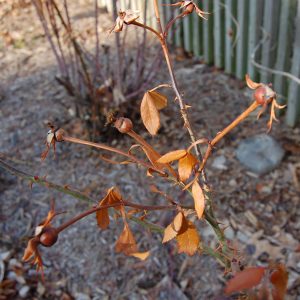Now’s the time to prepare your garden roses for the coming growing season. The three primary purposes of pruning are to remove damaged and unwanted canes, promote optimum blooming and reduce size of the plant, if needed.
Roses are best pruned before the new foliage emerges so that you can easily assess winter damage. Winter mulch and foam covers should be removed as soon as new growth becomes apparent. Since a spring freeze is still possible, it’s a good idea to keep the mulch nearby for quick protection.
The next step is to assess the plants for dieback and remove any dead, diseased or otherwise damaged canes. Even the hardiest roses will suffer some cane dieback, some years more so than others. Damaged canes will appear brown or black. Cut back badly damaged or dead canes down to the base of the plant. Slightly damaged canes only need to be cut back to healthy tissue. Be sure to cut back to an outward-facing bud so that new growth will occur toward the outside of the plant. This ensures good air circulation around the plant, which will help prevent disease infection. Completely remove any suckers or shoots that arise from the rootstock.
More specific pruning directions vary with the growth habit of the plant. Bush-type grafted roses should have 4-8 strong canes cut to a uniform height, spreading out away from the center of the plant in the shape of a V. Be sure to remove any canes that arise from below the graft union, whether on the trunk or from roots.
Pruning of climbing roses depends on their specific flowering habit. Ever-blooming climbers that flower throughout the growing season should need little pruning the first few years. As with all roses, remove any dead or weak wood. Thereafter, remove the oldest, longer canes that have become unproductive. Younger canes (2-3 years old) produce the most flowers and should be cut back to two or three healthy buds.
Ramblers and large-flowered climbers that bloom only once each year should be pruned immediately after blooms fade, since buds form on the previous year’s growth. As with raspberries, canes that bear flowers this year should be completely removed to allow space for the new canes to develop and produce buds for next year’s season.
Shrub roses rarely need to be shaped, and heavy pruning may destroy their natural beauty. Pruning of shrub roses should be limited to removal of dead or damaged wood and thinning of excessive growth.
More information on pruning and general rose care is available in Purdue Extension bulletin HO-128 “Roses,” which is online at http://www.hort.purdue.edu/ext/HO-128.pdf.
